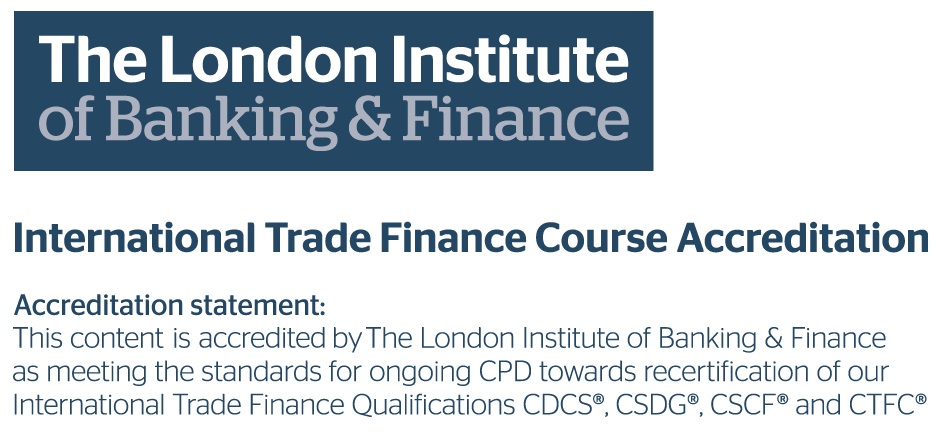Estimated reading time: 6 minutes
Listen to this podcast on Spotify, Apple Podcasts, Podbean, Podtail, ListenNotes, TuneIn
International trade has faced many challenges in recent years. In addition to COVID-19 taking a toll on the global economy, the conflict in Ukraine and subsequent sanctions against Russia have compounded the effects.
The International Chamber of Commerce (ICC) initially enacted the Uniform Customs and Practice (UCP) to help settle international trade transactions.
Given the geopolitical climate, the current version of the UCP 600 is a vital tool for banks and financial institutions (FIs) that trade internationally.
No more than ever, the UCP 600’s common practice guidelines for the documentary credit market are an invaluable asset for banks and corporates.
Trade Finance Global (TFG) spoke to UCP 600 expert David Meynell, senior technical advisor for the ICC Banking Commission and digital rules advisor to the Centre for Digital Trade and Innovation, to get more information.
Documentary Credits Explained
A documentary credit is a definite undertaking given by a bank to a seller, under the buyer’s instruction, for payment at sight or at a determinable future.
This bank undertaking is subject to the seller’s compliance with the terms and conditions that are stated in the documentary credit.
Documentary checks have existed for thousands of years and, throughout time, have naturally shifted in nature–from the Babylonian age all the way through to World War I.
These ever-changing needs have necessitated a clear set of adaptable rules–this being the latest UCP 600 rules.

UCP Explained
The UCP is a set of regulations, introduced by the ICC in 1933, designed to create a standard practice for documentary credits.
At the time, each nation had its own unique set of rules, making it particularly difficult for international firms to feel confident in their knowledge of the necessary requirements.
In light of this, the UCP provides four key advantages:
- Harmonisation throughout trade channels–as opposed to differing customs.
- A common understanding of terms and intentions.
- The ability to rely on a set of contractual rules, thus ensuring practitioners do not have to cope with often conflicting national regulations.
- A platform to conduct business between countries with widely divergent economic and judicial systems.
The UCP covers each step of a documentary credit including issuance, advising or confirmation, and examination of a document’s compliance.
The document also defines and interprets several key international trade terms and establishes the high-level requirements for several of the main trade documents.
Since the intent of the UCP is to facilitate international trade settlements, the articles surrounding the examination of documents are essential as this is an area that traditionally carries the most risk for banks.
It is important to note that the art of examination is not based on finding reasons for refusing to honour or negotiate a presentation.
In the field of international trade finance, maintaining the integrity of documentary credit products and UCP is of great importance.
The UCP 600 rules and why they are important
There are four main types of settlement methods in international trade: open account, documentary collection, documentary credit, and payment in advance.
David Meynell said, “Over eighty per cent of world trade is covered by open account, with documentary credits probably covering around thirteen per cent.”
The use of documentary credit is wide-ranging and varied, including the shipping of goods and provision of services.
Commoditised goods are often settled via documentary credit. Nevertheless, documentary credits can equally be issued for more unique purposes, such as the sale, leasing, or scrapping of a vessel or aircraft.
While the use of documentary credits is not mandatory in many countries, there are some central banks that require them when importing certain goods.
Incidentally, the issuance of a documentary credit is not exclusively confined to a bank–corporates can also issue them.

eUCP: how the rules are changing in line with e-document practices
A digital-first world requires a digital-first set of documentary credit rules.
Enter the Uniform Customs and Practice for Documentary Credits for Electronic Presentation (eUCP).
The eUCP focuses on the presentation of electronic records, either alone or in combination with paper documents. They do not focus on the issuance of a credit.
The eUCP rules were first published as version 1.0 on 31 March 2002 and a revised version (1.1) was released in conjunction with the UCP 600 in July 2007. Through this revision, the rules were updated to comply with UCP 600’s changes in terminology.
The latest version, 2.0, is known as Uniform Customs and Practice for Documentary Credits (UCP 600) Supplement for Electronic Presentations and has been in force since 1 July 2019.
Both sets of ICC eRules, eUCP and Uniform Rules for Collections (eURC), were drafted using version numbers (eUCP 2.0 and eURC 1.0) indicating intent for frequent revisions and updates.
The ICC eRules drafting committees recognised that five-, ten-, or even fifteen-year update periods–the historic standard for most updates–would simply not suffice considering the rapid pace of digital advancement.
Given that these rules came into force three years ago, it is reasonable to expect discussions for new versions to begin within the next twelve months.
To sum up, David Meynell said, “It is inevitable that traditional trade instruments will, over time, inexorably move towards a mixed ecosystem of paper and digital, and, ultimately, to electronic records alone.”
The nature of UCP 600 supplements
The UCP 600 are supplemented by:
- ICC Uniform Rules for Bank-to-Bank Reimbursements under documentary credits (URR 725);
- ICC Supplement to the Uniform Customs and Practice for documentary credits for Electronic Presentation (eUCP) version 2.0; and
- International Standard Banking Practice (ISBP) for the Examination of Documents under UCP 600 (ISBP Publication No. 745).
David Meynell added, “With regard to the ISBP, it’s important to note that it does not amend UCP 600. Instead, it explains how practices articulated in the UCP 600 are to be applied by documentary credit practitioners.
“Applied correctly, ISBP helps reduce the large percentage of documents refused for discrepancies on the first presentation.”
It is pertinent to add that a revision of ICC rules may be on the horizon.
The ICC National Committees have been asked to provide feedback on their opinion with regard to the content and structure of UCP 600 and ISBP 745, together with specifying the type of modifications that should be made.
A deadline of September this year has been given and, at that stage, an evaluation and analysis of the feedback will commence.
The ICC National Committees had previously made it clear there are no existing problems with the rules themselves, but rather with their application.
If any revisions come to fruition, credit transactions are likely to be made easier, reducing instances where differing opinions on document compliance may take place.
Such disputes that arise between involved parties are generally resolved quickly and documents are processed without referral to any arbitration or legal process. However, on occasion, the involvement of a third party can be required.
A significant number of disputes have been answered via the ICC arbitration service known as the Documentary Dispute Resolution Expertise (DOCDEX).
The purpose of DOCDEX is to provide parties with a specific dispute resolution procedure that leads to an independent, impartial, and prompt expert decision.
The process is monitored and handled by the ICC International Centre for Expertise.





























